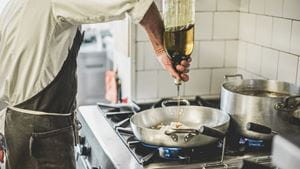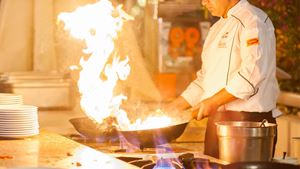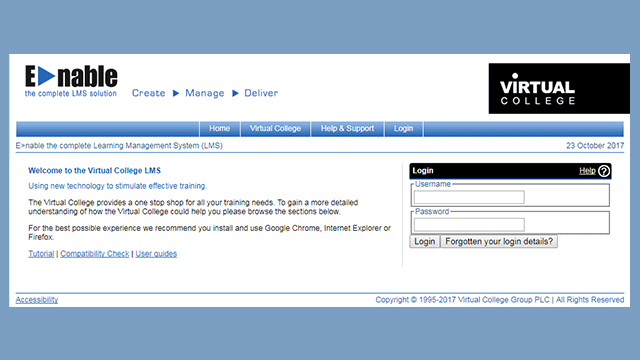What Is Safe Food Handling?
Safe food handling is something that everyone has to consider, whether they’re cooking for themselves or handling food as part of their job. But when it comes to businesses that manage the production or preparation of food products, there are plenty of aspects of health and safety that you are legally required to consider and implement in order to keep your brand, your customers, and your staff safe.
Safe food handling is influenced by a range of factors, from the clothes the person touching the products is wearing to the environment in which the food is being handled. In this article, we cover the key elements of safe food handling practices and procedures, along with explaining why these practices are so important.
Key Safe Food Handling Practices and Procedures
There is plenty of guidance available on the best practices for safely handling food in the workplace, both as part of official legislation and from other regulatory bodies like the World Health Organisation. These safe food handling instructions can loosely be grouped into five different categories, which we’ll explore in more detail below.
Clean
When you’re handling food, one of the best places to start when ensuring health and safety is by keeping the handling environment and the handler clean.
First, clean hands are essential. Before and after any food handling task, you should wash your hands for at least twenty seconds to be sure that there aren’t any harmful substances on them that could contaminate the food or that any contaminants from the food are now present on your hands.
Next, ensure that the work environment is clean or at least the area in which food is going to be handled. Disinfect surfaces before and after food handling tasks to again avoid cross-contamination between the products and the surfaces they’re placed on.
Finally, ensure that the equipment you’re using has been cleaned. In situations where cross-contamination is highly likely, you should clean equipment both before and after handling food to be on the safe side, but at the very least you should ensure that things like utensils, chopping boards and containers are thoroughly cleaned after use and before they’re put away.
If the ingredients you’re handling can be cleaned, you should also do this before preparing them. Things like raw fruit and vegetables should always be scrubbed before they’re cooked or prepared, even if they have skins or rinds that won’t be eaten.
Separate
Keeping ingredients and equipment separate is one of the most effective things you can do to prevent cross-contamination. This is because some products are much more likely to carry harmful bacteria than others, so separation measures need to be taken to reduce this risk.
Food products like raw meat, raw fish and eggs should be stored away from all other ingredients, and ideally kept within their own containers in the fridge or the freezer to avoid any juices dripping onto other items. You should also use separate equipment like knives and chopping boards to prepare these products, and store this equipment separately from others in the kitchen even when it has been cleaned.
It probably goes without saying, but you should always clean equipment and surfaces that raw meat, seafood or eggs have come into contact with immediately afterwards, and avoid letting other items touch these before they’re disinfected.
Cook
Cooking food incorrectly can be a major cause of health and safety issues, as heating things to the wrong temperatures can create an environment where potentially harmful bacteria rapidly grow and multiply, or fail to kill harmful bacteria that may already be present.
Firstly, avoid heating food to a temperature between 8°C and 60°C, which is known as ‘the danger zone’. This is where bacteria are most likely to multiply and thrive, so all products that are handled need to be kept outside of this temperature range.
Once food has been cooked, the only way to ensure that it has reached a safe temperature is to use a food thermometer. This needs to be inserted right into the middle of the product and kept there for several seconds to get an accurate reading.
If you’re cooking food in a microwave, you need to regularly stir the product to make sure that it gets heated all the way through, and again check this with a thermometer to be sure it’s reached a high enough temperature.
Meat and fish are the products you need to be the most careful with when it comes to safe cooking, as these are the ingredients that present the biggest risk in terms of harmful bacteria. Eggs are another product that needs extra care when cooking, as uncooked eggs can contain very dangerous bacteria so they must always be heated thoroughly before being eaten.
Cooking guidelines also need to be followed when reheating food, as all of the potential risks are still present in products that have already been cooked before.
Temperature
Temperature in food handling refers to the temperature of the product, but also to the temperature of the food preparation environment.
Firstly, if you’re handling food that has just been cooked then it needs to be handled as quickly as possible to ensure it retains a safe temperature and doesn’t cool to a point where it enters the danger zone. Some food products may be hotheld after being handled so that they can be served safely over a long period of time, and the temperature of these needs to be checked regularly to ensure that no dangerous bacteria gets the chance to grow.
Temperature in safe procedures for handling food mainly refers to keeping products chilled however, as this also stops harmful bacteria from being able to grow and contaminate anything. Products that come from the fridge should be handled and served quickly so that they don’t reach room temperature, and anything that has been cooked needs to be stored in the fridge once it has cooled down and consumed within 2 - 3 days.
You should also think about the temperature of the environment you’re handling food in. If the room is very warm then food products will either quickly warm up or fail to cool down within the recommended time, which increases the likelihood of bacterial contamination. You should keep the food preparation environment cool where possible by installing air conditioning or opening windows, but make sure that this doesn’t mean that potential contaminants can enter the kitchen from outside.
Ingredients
Finally, certain products and ingredients need extra consideration if involved in food handling.
Raw food and materials may contain potentially harmful bacteria, and therefore need to be handled away from other products and properly cleaned or cooked before serving. You should also be careful with foods that may not have been processed safely, like unpasteurised milk or cheese.
The cleanliness of the water used in food preparation may also need to be considered, although this isn’t really a problem in countries like the UK.
Finally, be mindful of the expiration date of any ingredients you handle. Whilst at home you may still decide to eat products that are a couple of days past their ‘best before’, but when you’re handling or serving food at work this could get you into serious legal trouble, so always check dates and throw away anything that is past its best.
Why is Safe Food Handling Important?
Safe food handling is important firstly because it keeps people safe. Adhering to safe food handling standards means that the chances of harmful cross-contamination are low which prevents illness and infection in both the people preparing the food and the people consuming it.
Keeping staff safe when handling food also leads to them feeling more confident at work. This in turn creates a better working environment and also makes people more productive, which is great for business.
Safe food handling and good food hygiene in general is a requirement of many pieces of legislation that affect businesses. Following guidelines and adhering to regulations means that you will avoid facing any legal action and maintain a solid reputation as a business that handles food products.
FAQs
Where should you wash food handling equipment?
Food handling equipment should be washed in a separate sink than the one where people wash their hands in a kitchen. This is to prevent cross-contamination by stopping any harmful contaminants on kitchen equipment from being transferred to people’s hands, and vice versa.
Why should you wear protective clothing when handling food?
There is a range of reasons why you should wear protective clothing, such as aprons, hairnets and gloves, whilst handling food. The first is that this PPE can stop physical contaminants like jewellery, hair or other objects from contaminating the food you’re preparing, which could pose a safety risk to customers.
You may also potentially have harmful bacteria on your hands or clothes, which protective clothing will prevent from being transferred to food products.
Protective clothing in a kitchen can also keep you safe from harm by providing another layer of fabric to guard against splashes or burns. From strong cleaning chemicals to hot ingredients, wearing things like aprons or gloves protects your skin and reduces the risk of injury.
Why must nail polish not be worn while handling food?
Nail polish has the potential to chip or flake, and if you’re handling food with your bare hands then these tiny particles could potentially contaminate it. Therefore, most employees that handle food as part of their role are not allowed to wear nail varnish when they’re at work because it creates a risk of chemical contamination.
Summary
Food handling is something that many of us do without thinking. However, there are plenty of health and safety considerations to make whilst doing so that ensure that the food stays safe to eat and that the surrounding area also remains clean and uncontaminated. Remembering the five key areas listed above will help you to remember what to bear in mind when it comes to establishing a safe food handling policy, along with consulting relevant legislation that will list the necessary actions you need to take to stay safe.
If you’re interested in finding out more about food safety hazards and how to prevent them, this topic and many more are covered in our online ‘Level 1 Food Safety and Hygiene’ and ‘Level 2 Food Safety & Hygiene’ courses.

























































